MasterSu: The Sustainable Development of Su Embroidery Based on Digital Technology
Abstract
:1. Introduction
2. Related Works
2.1. Research on the Sustainability of Intangible Cultural Heritage: The Example of Su Embroidery
2.2. Digital Preservation of Intangible Cultural Heritage
2.3. The Computer-Aided Technology for Embroidery
3. Method
3.1. Image Information Extraction
3.1.1. Morphological Parameter Extraction
3.1.2. Color Parameter Extraction
3.2. Su-Embroidery Stitch Design
3.2.1. Starting Layer
3.2.2. Transition Layer
- Stable transition means that the number of upper-layer endpoints is the same as the number of lower-layer start points, as shown in Figure 7a.
- Convergent transition means that the number of endpoints of the upper layer is more than the number of starting points of the lower layer, as shown in Figure 7b, resulting in some embroidery thread lengths smaller than the standard parameters. If the threads intersect, the coordinates of the intersection point are calculated and the starting point is connected to the intersection point; otherwise, the endpoint is calculated with standard parameters and recorded as the starting point of the next layer.
- An expansive transition means that the number of endpoints of the upper layer is less than the number of starting points of the lower layer, as shown in Figure 7c. In this case, the new starting point of the embroidery thread needs to be obtained from the object outline. Then, the endpoint is calculated based on the embroidery thread parameters and the object outline, and it is recorded as the starting point of the next layer.
3.2.3. Finishing Layer
3.3. Color-Information Mapping
4. Results
5. Evaluation of MasterSu
5.1. Procedure
5.2. Usability-Test Results
6. Discussion
7. Conclusions and Future Work
Author Contributions
Funding
Institutional Review Board Statement
Informed Consent Statement
Data Availability Statement
Acknowledgments
Conflicts of Interest
References
- World Commission on Environment and Development. Our Common Future; Oxford University Press: Oxford, UK, 1995. [Google Scholar]
- Soini, K.; Birkeland, I. Exploring the scientific discourse on cultural sustainability. Geoforum 2014, 51, 213–223. [Google Scholar] [CrossRef]
- Loach, K.; Rowley, J.; Griffiths, J. Cultural Sustainability as A Strategy for The Survival of Museums and Libraries. Int. J. Cult. Policy 2017, 23, 186–198. [Google Scholar] [CrossRef]
- Kurin, R. Safeguarding Intangible Cultural Heritage in the 2003 UNESCO Convention: A critical appraisal. Mus. Int. 2004, 56, 66–77. [Google Scholar] [CrossRef]
- Kim, S.; Im, D.U.; Lee, J.; Choi, H. Utility of digital technologies for the sustainability of intangible cultural heritage (ICH) in Korea. Sustainability 2019, 11, 6117. [Google Scholar] [CrossRef] [Green Version]
- Dang, Q.; Luo, Z.; Ouyang, C.; Wang, L.; Xie, M. Intangible cultural heritage in China: A visual analysis of research hotspots, frontiers and trends using CiteSpace. Sustainability 2021, 13, 9865. [Google Scholar] [CrossRef]
- Xiao, M.L. Exploration of customs in The State of Wu and Yue. Southeast Cult. 1988, Z1, 83–88. [Google Scholar]
- Song, G.Y. The cultural characteristics of Suzhou Embroidery. Lit. Cont. 2010, 4, 142–144. [Google Scholar]
- Jia, J.; Zhang, J.Q. Analysis on stitch method and match colors of Suzhou Embroidery in modern female jacket. J. Silk 2014, 51, 48–53. [Google Scholar]
- Zhong, X.; Chudasri, D. A review of traditional embroidery from China in relation to knowledge management and Design. In Proceedings of the 2019 Joint International Conference on Digital Arts, Media and Technology with ECTI Northern Section Conference on Electrical, Electronics, Computer and Telecommunications Engineering (ECTI DAMT-NCON), Nan, Thailand, 30 January–2 February 2019; IEEE: Piscataway, NJ, USA, 2019; pp. 276–281. [Google Scholar]
- Li, X.; Jiang, H.; Nam, K.M. Adaptation in cultural industry under conservation pressure: Case study of two Chinese Embroidery clusters. Int. J. Cult. Policy 2020, 26, 202–222. [Google Scholar] [CrossRef]
- Yu, J.; Zheng, X.; Cao, Q. Application research on graphic language in the innovative design of modern Suzhou Embroidery patterns. In Proceedings of the 2018 8th International Conference on Education, Management, Computer and Society (EMCS 2018), Shenyang, China, 2–4 November 2018; Francis Academic Press: Oxfordshire, UK, 2019. [Google Scholar] [CrossRef]
- Di, L.; Zhang, J.; Li, X. Research on Main Stitches of Painting Embroidery and Embroidered Costume in Soochow Embroidery. Silk 2012, 49, 50–54. [Google Scholar]
- Su, Z.; Ouyang, X. Research on the Application of Computer Embroidery Skills in Modern Chinese Fashion Design. J. Phys. 2021, 1992, 032004. [Google Scholar] [CrossRef]
- Zhao, H.; Xu, Z.; Zhang, J. Research on Uygur Carpet Pattern Digital Technology. J. Text. Res. 2012, 33, 142–145. [Google Scholar]
- Kuo, C.F.J.; Jian, B.L.; Tung, C.P.; Wu, H.C. Automatic Machine Embroidery Image Color Analysis System, Part II: Application of The Genetic Algorithm in Search of a Repetitive Pattern Image. Text. Res. J. 2012, 82, 1099–1106. [Google Scholar] [CrossRef]
- Yang, L.; Xiong, Y. Between Tradition and Innovation: Research on The Inheritance, Protection and Industrial Development of Suzhou Embroidery. Ethn. Art Stud. 2017, 30, 119–126. [Google Scholar]
- Takahashi, Y.; Fukusato, T. Stitch: An interactive design system for hand-sewn embroidery. In ACM SIGGRAPH 2018 Posters; ACM: New York, NY, USA, 2018; pp. 1–2. [Google Scholar]
- Idris, M.Z.; Mustaffa, N.B.; Yusoff, S. Preservation of Intangible Cultural Heritage Using Advance Digital Technology: Issues and Challenges. J. Arts Res. Educ. 2016, 16, 1–13. [Google Scholar] [CrossRef]
- Palombini, A. Storytelling and telling history. Towards A Grammar of Narratives for Cultural Heritage Dissemination in the Digital Era. J. Cult. Herit. 2017, 24, 134–139. [Google Scholar] [CrossRef]
- Zhao, S.L. On the essence of the inheritance of ethnic cultures. J. Peking Univ. 2002, 3, 10–16. [Google Scholar]
- Wu, Q.; Bai, G. Digital Experience Design of Traditional Cultures in The Perspective of Aesthetic Education. Art Des. 2021, 7, 12–17. [Google Scholar]
- Zhang, X.; Li, Y.; Lin, J.; Ye, Y. The Construction of Placeness in Traditional Handicraft Heritage Sites: A Case Study of Suzhou Embroidery. Sustainability 2021, 13, 9176. [Google Scholar] [CrossRef]
- Guo, Q. Research on The Ways to Protect and Inherit Intangible Cultural Heritage in The Information Age. J. Phys. Con. Ser. 2020, 1575, 012169. [Google Scholar] [CrossRef]
- Yue, Z.; Zhou, Y. A Review of The International Research on Digital Preservathetion of Intangible Cultural Heritage. Library 2017, 8, 59–68. [Google Scholar]
- Wang, W.; Hong, K. Build communication protection platform of intangible cultural heritage expand channel of open access to shared information resources. In Proceedings of the 5th International Conference on Cooperation and Promotion of Information Resources in Science and Technology (COINFO 2010), Beijing, China, 27–29 November 2010; pp. 111–116. [Google Scholar]
- Cai, W. Preservation and Application of Digital Technology in Intangible Cultural Heritage Paper-Cutting. China Pulp Pap. 2021, 40, 5–6. [Google Scholar]
- Hatır, E.; Korkanç, M.; Schachner, A.; İnce, İ. The deep learning method applied to the detection and mapping of stone deterioration in open-air sanctuaries of the Hittite period in Anatolia. J. Cult. Herit. 2021, 51, 37–49. [Google Scholar] [CrossRef]
- Hatır, M.E.; İnce, İ.; Korkanç, M. Intelligent detection of deterioration in cultural stone heritage. J. Build. Eng. 2021, 44, 102690. [Google Scholar] [CrossRef]
- Lv, Y.C. Digital Protection and Dissemination of Intangible Cultural Heritage—Taking Suzhou Embroidery as an Example. Stud. Nat. Cult. Herit. 2019, 4, 53–55. [Google Scholar]
- Wang, Q.; Zhe, Z.; Xing, Y. Research on the Spread of Embroidery Art and Non-material Culture and Art in The Internet Multimedia Age. J. Phys. 2019, 1345, 032012. [Google Scholar] [CrossRef] [Green Version]
- Huang, X.M.; Meng, L.L.; Zhou, K. Application of Computer Embroidery in Home Textile Design. Shanghai Text. Technol. 2012, 40, 23–24. [Google Scholar]
- Mikherskii, R.M. Application of an Artificial Immune System for Visual Pattern Recognition. Comput. Opt. 2018, 42, 113–117. [Google Scholar] [CrossRef]
- Liu, H.T.; Guo, L.; Chen, S.F. Design and Implementation of Intelligent Environment for Computer Embroidery Programming. J. Softw. 2001, 9, 1399–1404. [Google Scholar]
- Wu, M.; Chen, T.; Lv, G.; Chen, M.; Wang, H.; Sun, H. Identification and Formalization of Knowledge for Coloring Qualitative Geospatial Data. Color Res. Appl. 2018, 43, 198–208. [Google Scholar] [CrossRef]
- Hsiao, S.W.; Yang, M.H. A Methodology for Predicting the Color Trend to Get a Three-Colored Combination. Color Res. Appl. 2017, 42, 102–114. [Google Scholar] [CrossRef]
- Zhang, Y. The Evolution and Development of Modern Su Embroidery Technique. Front. Art Res. 2021, 3, 32–37. [Google Scholar]
- Jie, Z.; Sun, Z.X.; Yang, K.W. A Controllable Stitch Layout Strategy for Random Needle Embroidery. J. Zhejiang Univ. Sci. C 2014, 15, 729–743. [Google Scholar]
- Yang, K.; Sun, Z. Paint with stitches: A Style Definition and Image-based Rendering Method for Random-needle Embroidery. Multimed. Tools Appl. 2017, 77, 12259–12292. [Google Scholar] [CrossRef]
- Swain, M.J.; Ballard, D.H. Color Indexing Readings in Multimedia Computing and Newworking; Elsevier Inc.: Amsterdam, The Netherlands, 2002; pp. 265–277. [Google Scholar]
- Liu, X.J.; Chao, Y.J.; Zhao, L.X. Color Network of Traditional Culture Patterns and Color Design Aiding Tecnology. Comput. Integr. Manuf. Syst. 2016, 22, 899–907. [Google Scholar]
- Li, Y.; Liu, X.J.; Zhao, Y. Color Adjacent Network Model for Product Color Design. Comput. Integr. Manuf. Syst. 2019, 25, 2355–2364. [Google Scholar]
- Bastien, J.M.C. Usability testing: A review of some methodological and technical aspects of the method. Int. J. Med. Inform. 2010, 79, e18–e23. [Google Scholar] [CrossRef] [Green Version]
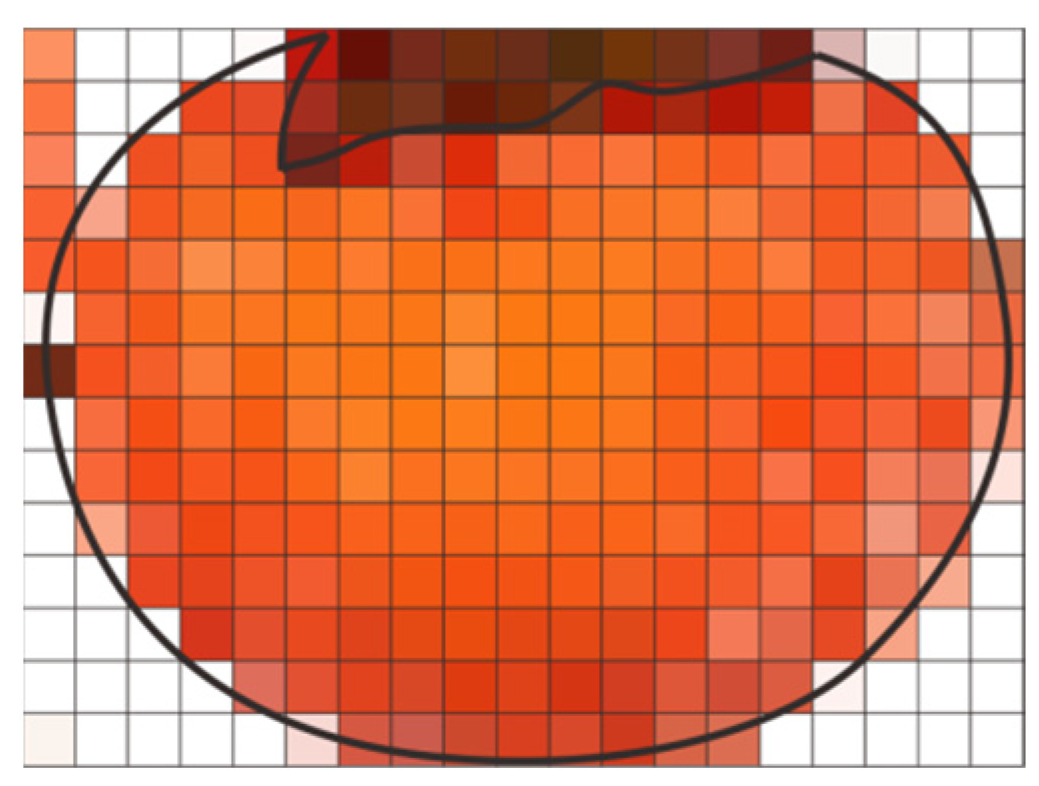
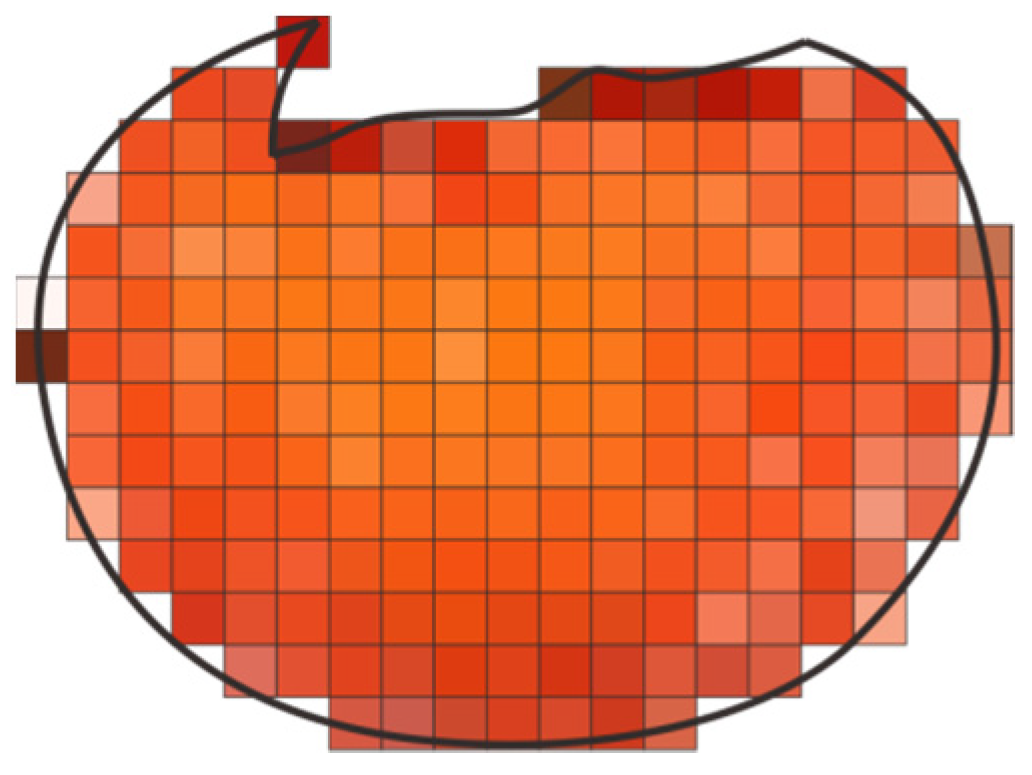
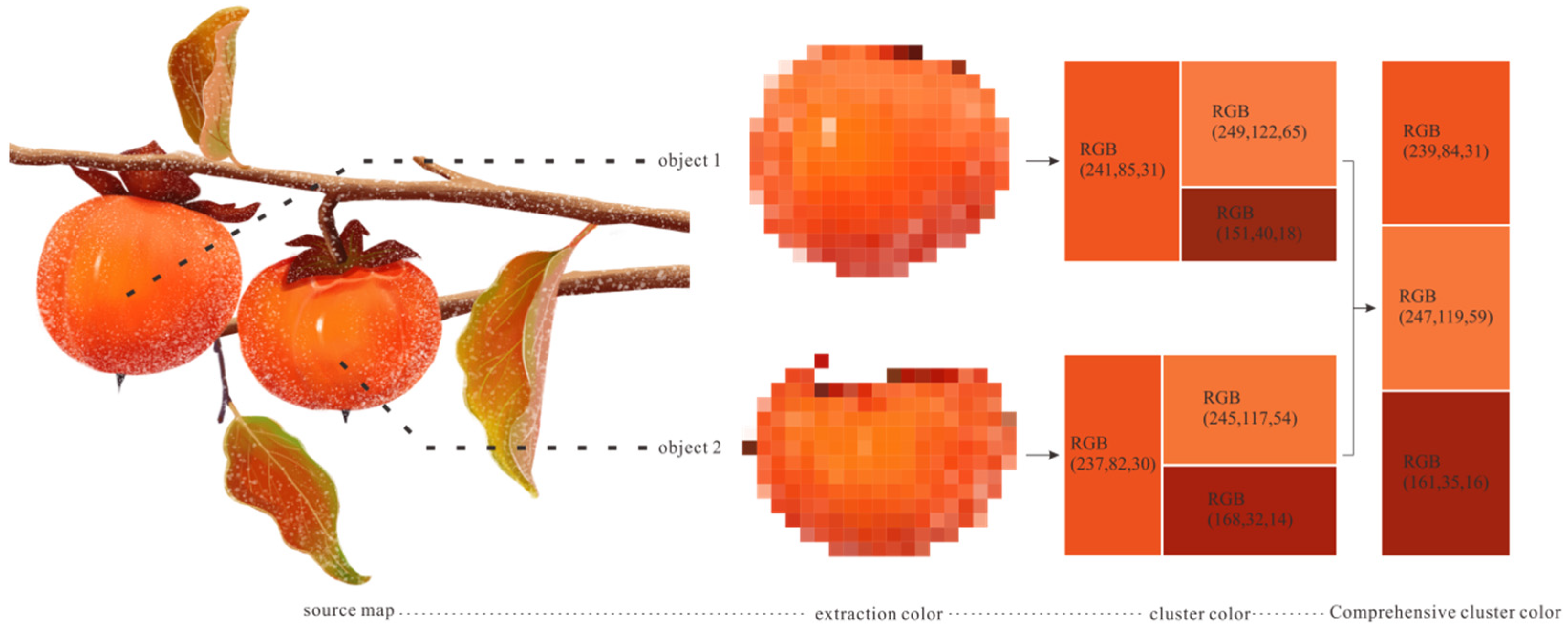
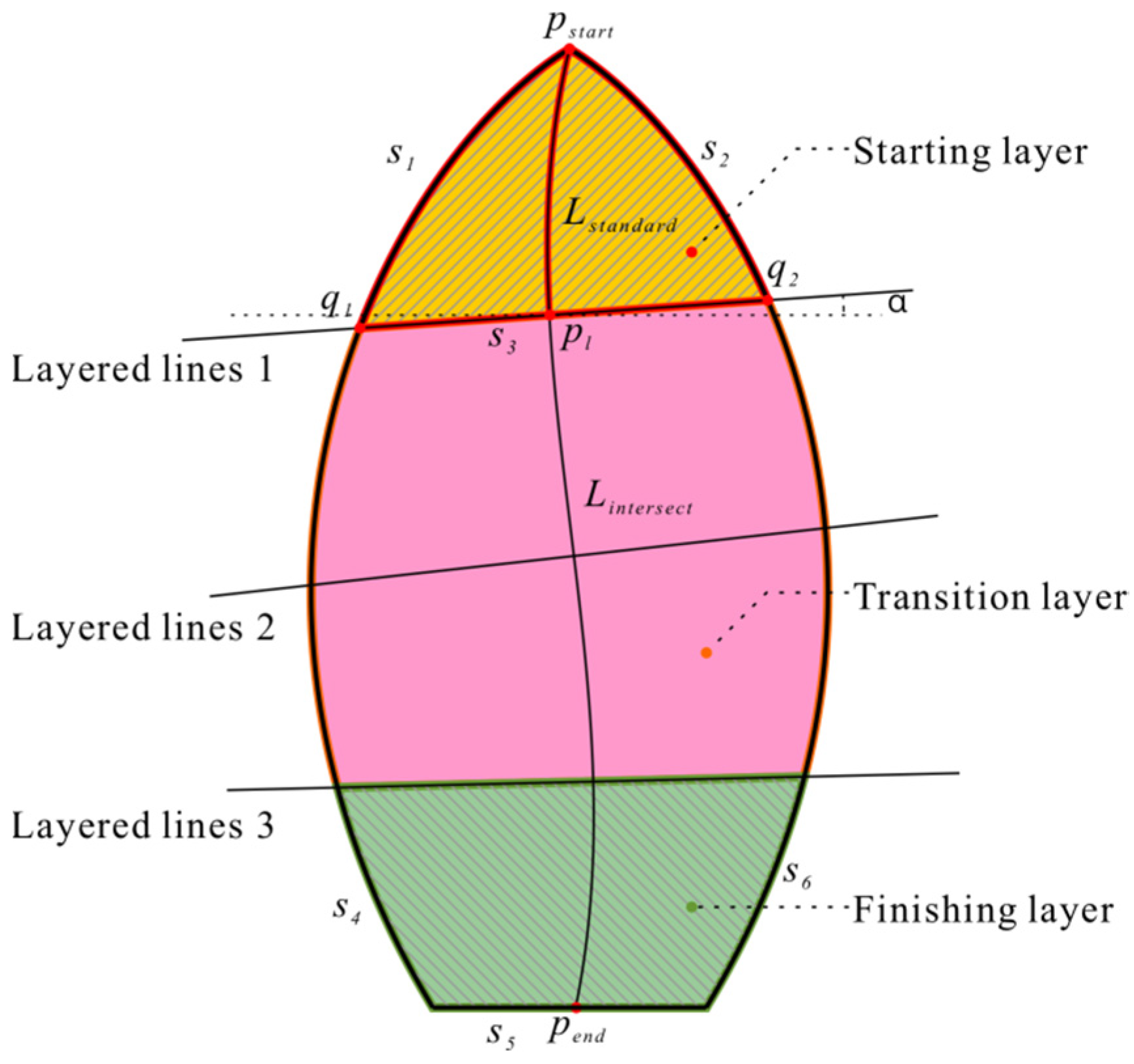
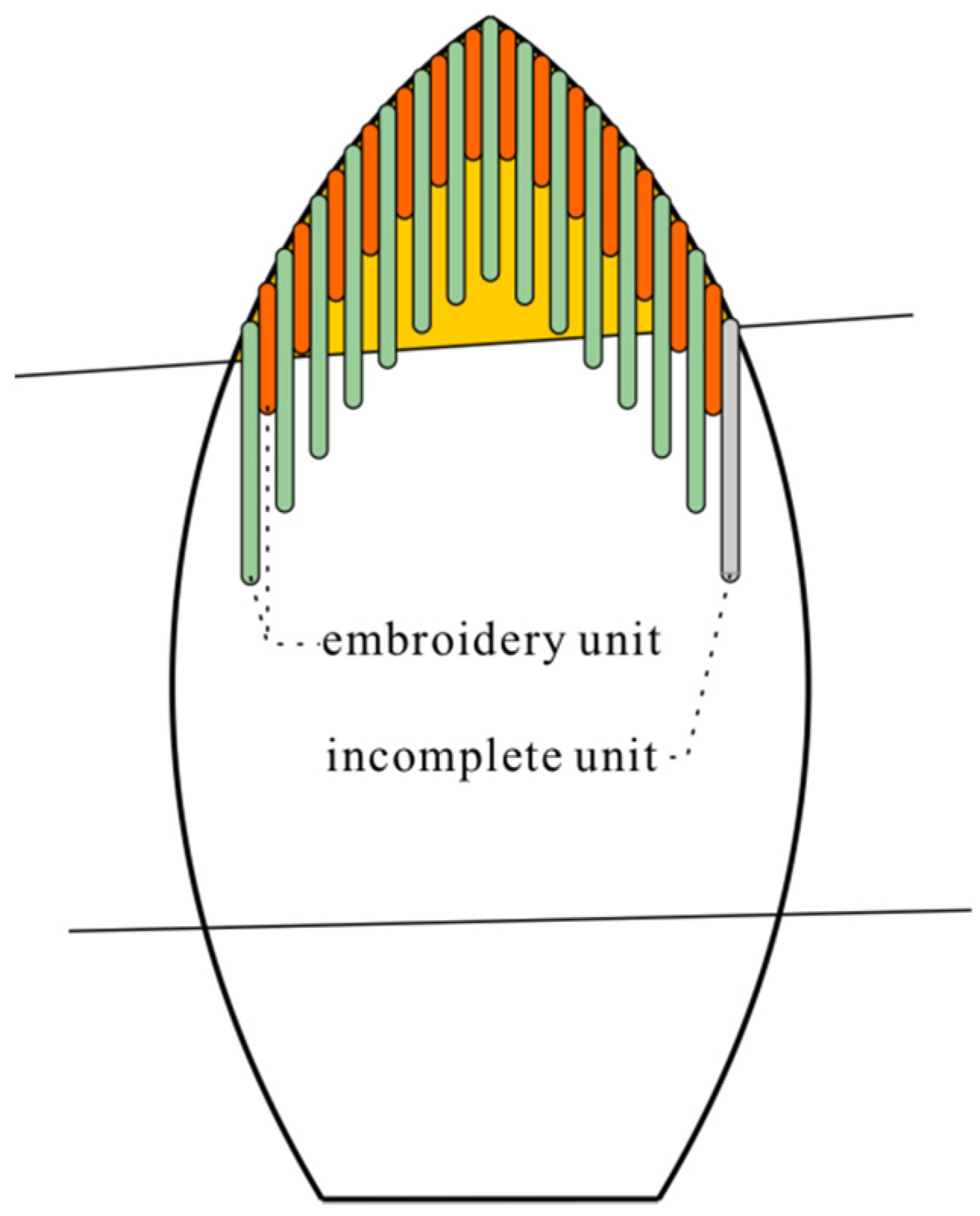
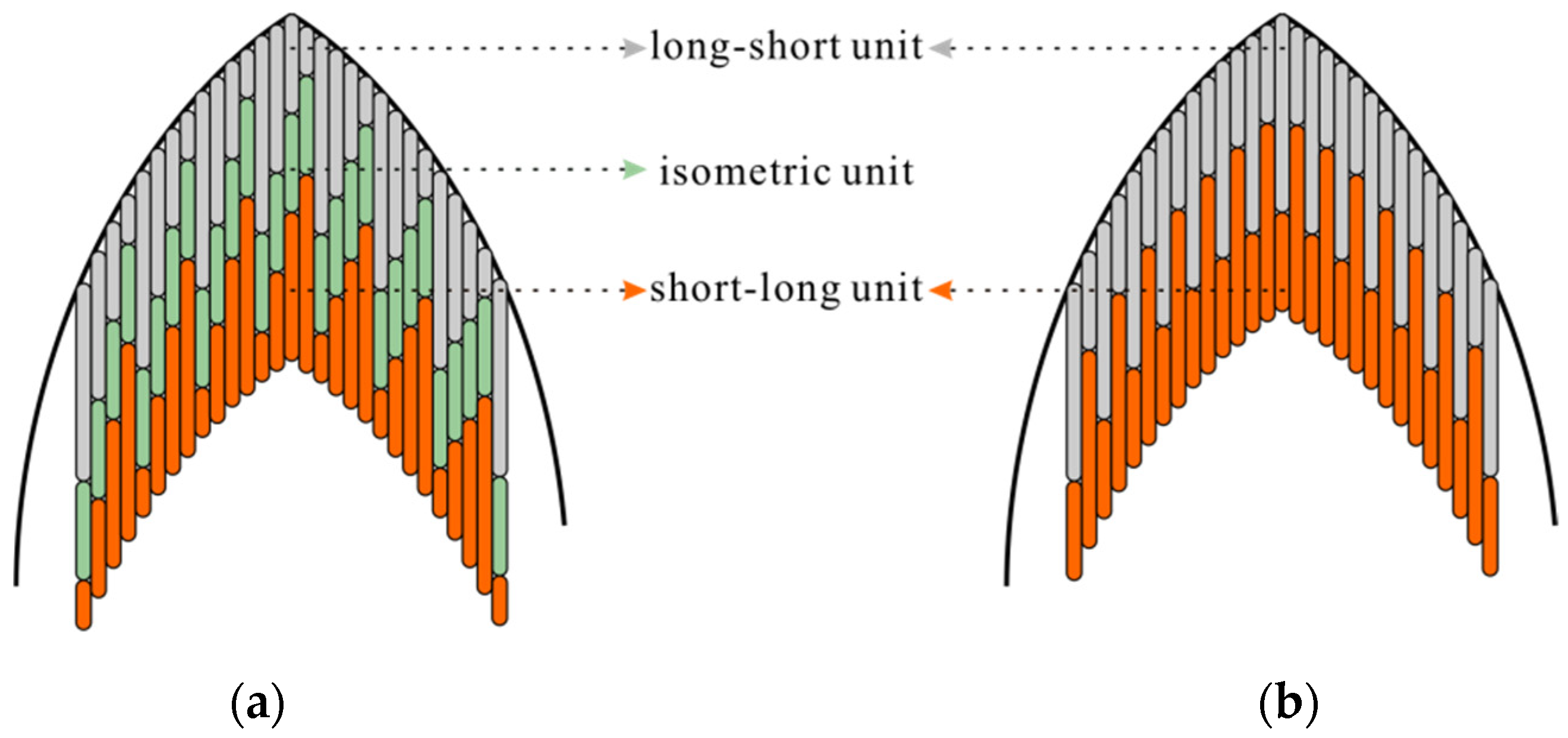
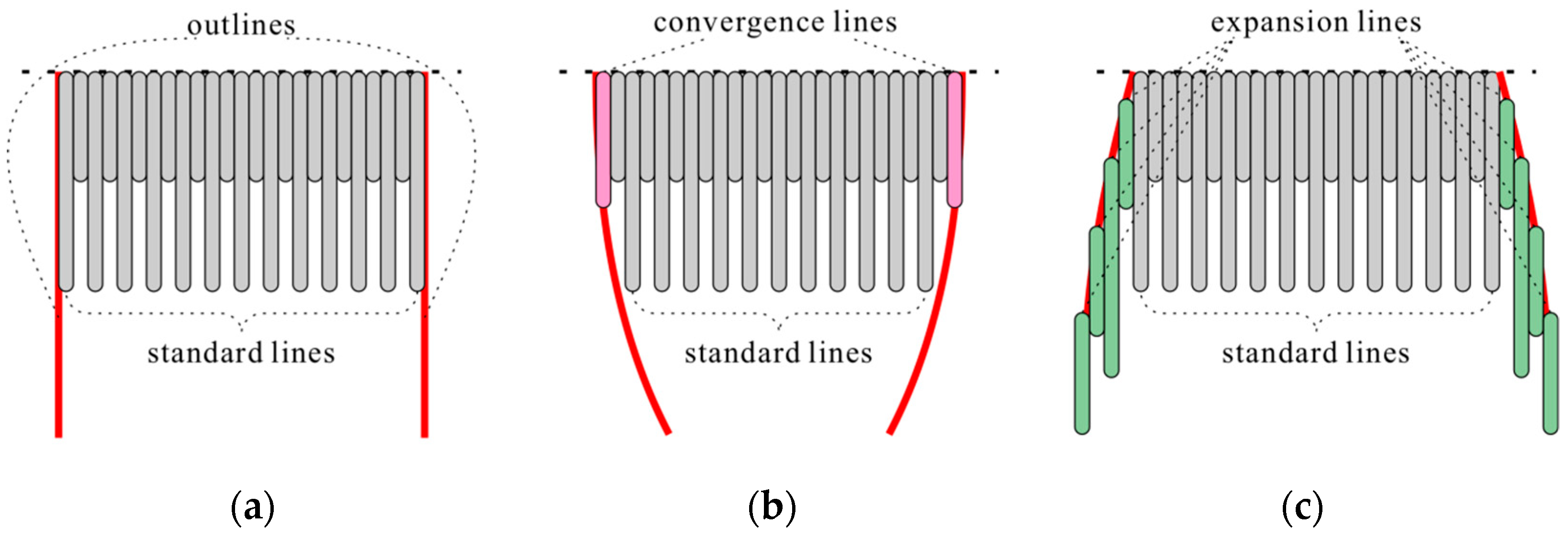
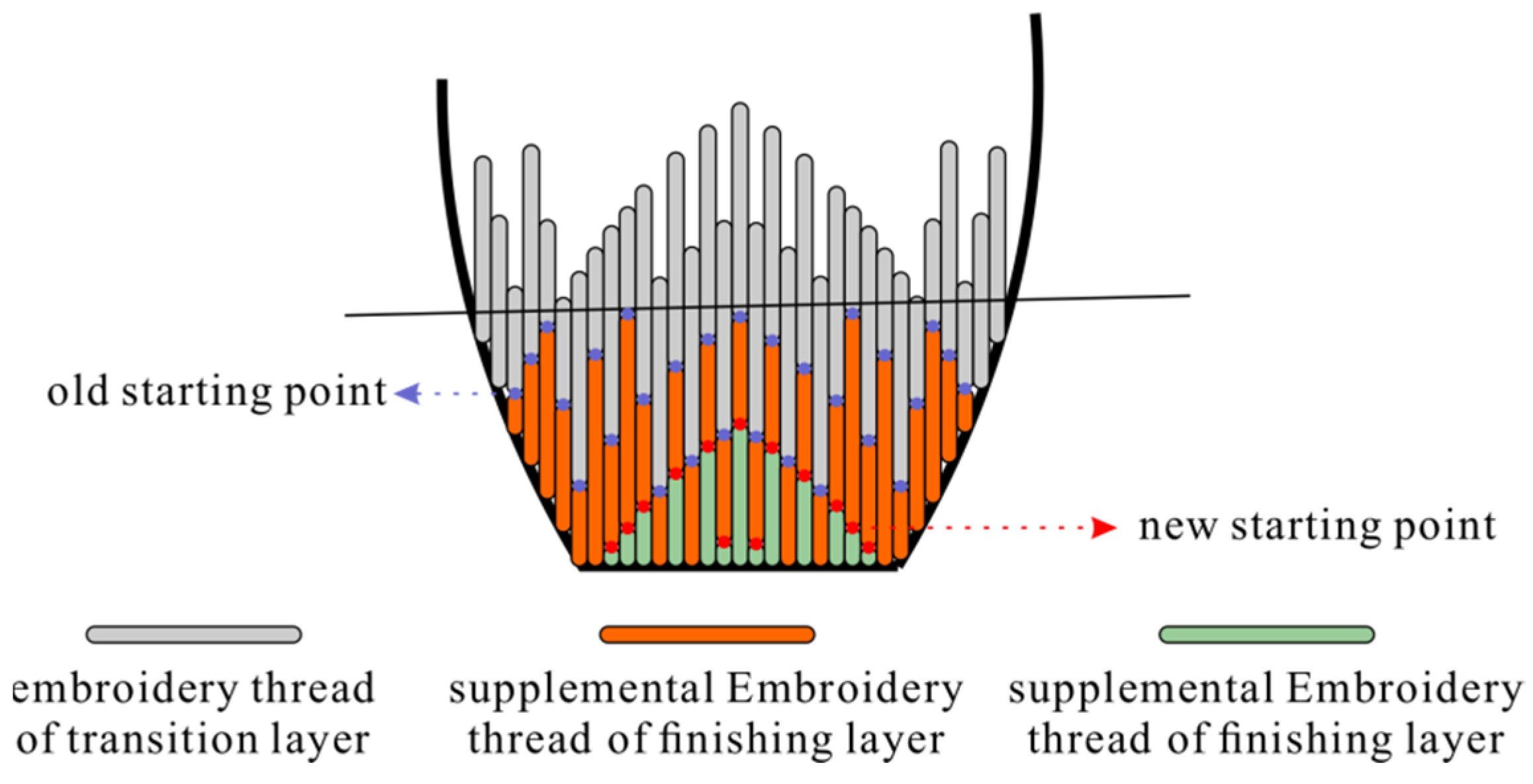

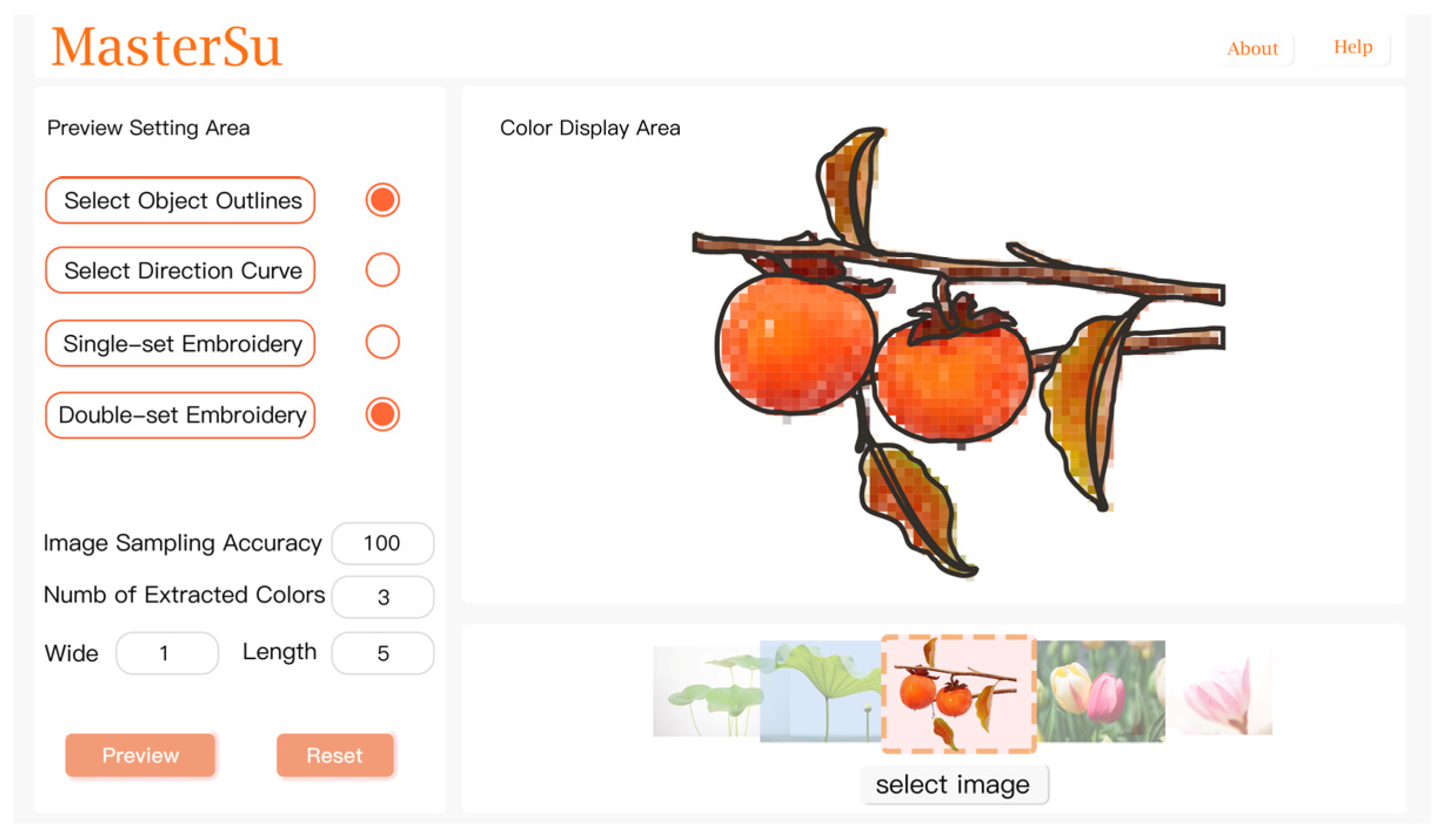
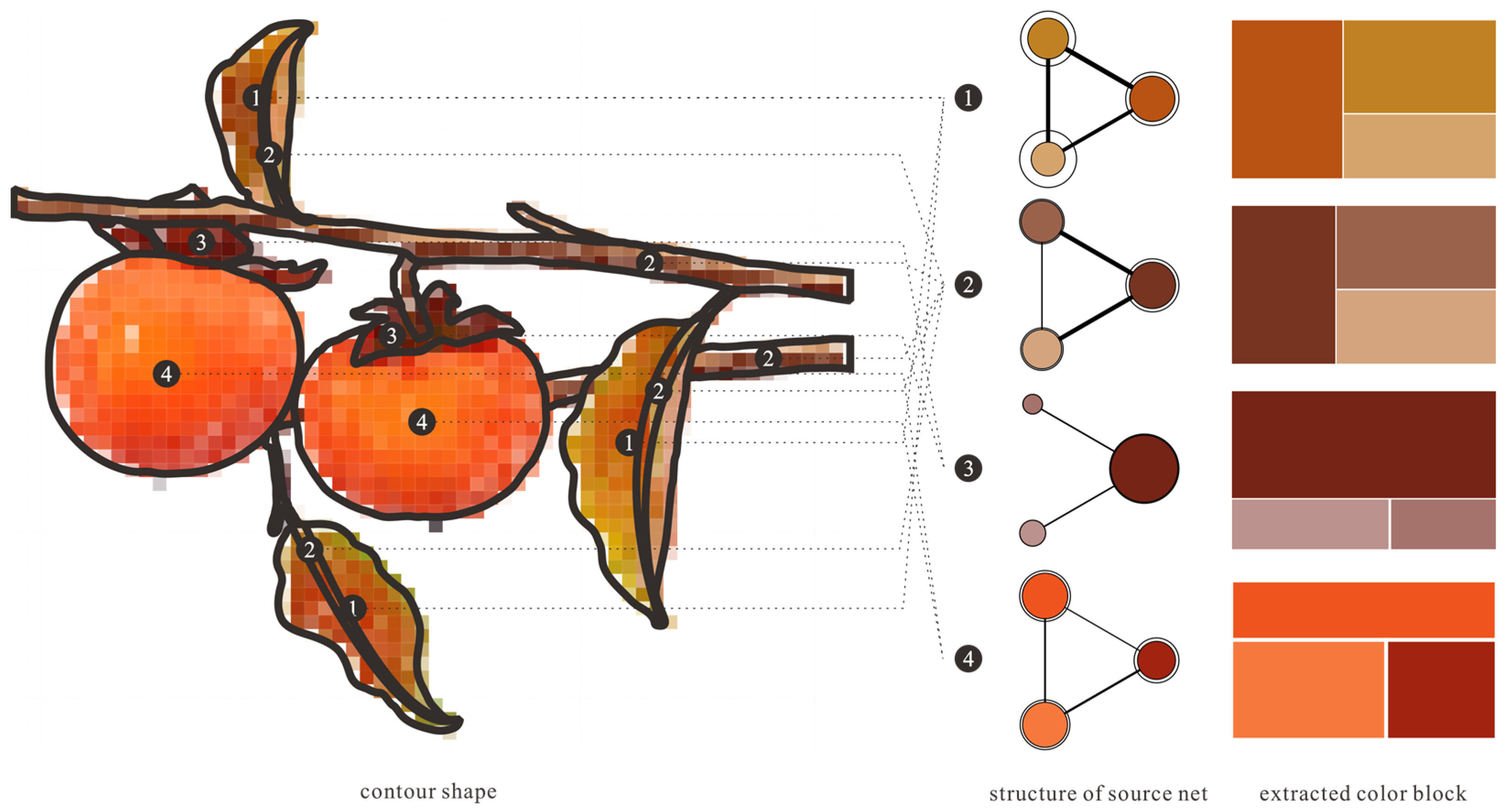
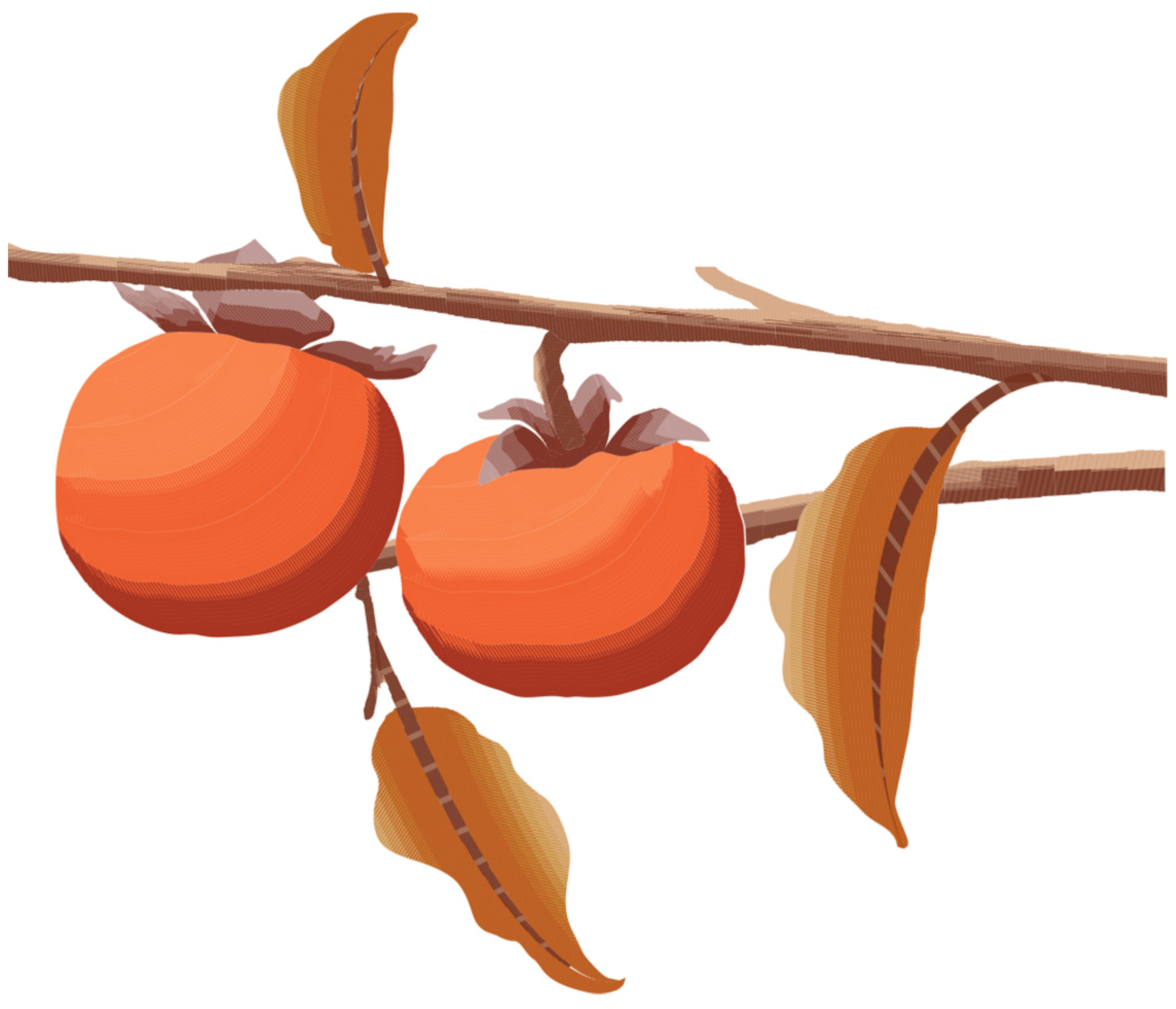
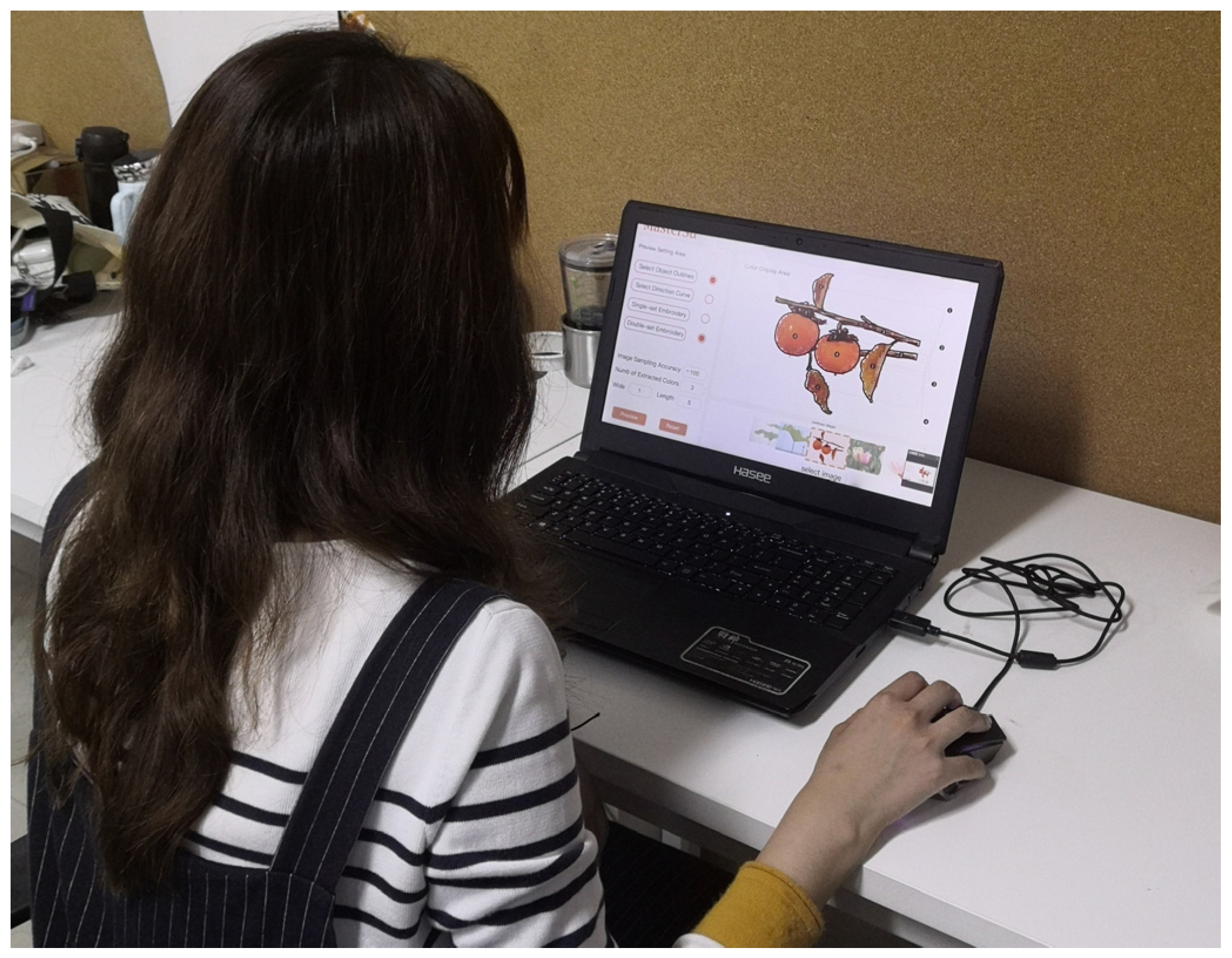

| No. | Variegated Stitch Method | Embroidery Method | Illustrations |
|---|---|---|---|
| 1 | Single-variegated stitch | The first batch starts from the edge of the needle, the edge of the mouth, neatly; the second batch in the first batch of needle drop, the first batch needs to leave a line of clearance to allow the second batch of needles; the third batch needs to turn into the end of the first batch by a centimeter, and then leave the fourth batch of needle clearance. |  |
| 2 | Double-variegated stitch | The embroidery method is similar to that of a single-variegated stitch but deeper and shorter than a single-variegated stitch. The difference is that the fourth batch is connected to the first batch, i.e., the second batch is connected to three-quarters of the first batch, the third batch is connected to two-quarters of the first batch, and the fourth batch is connected to one-quarter of the first batch. |  |
| 3 | Wooden comb-variegated stitch | The embroidery method is similar to that of a single-variegated stitch but looser and thinner than a single-variegated stitch. The difference lies in the fact that after the first batch comes out of the edge, the second batch drops the stitches at half of the first batch, and every other thread sets a stitch, and the second batch accesses a centimeter of the end of the first batch, and clips in the gap left by the second batch. |  |
| 4 | Set-variegated stitch | The embroidery method is similar to that of a single-variegated stitch, but the difference lies in the fact that the first batch of stitches at the outer mouth is larger, the embroidery batch is less than the number of stitches, and the batch hides short stitches. At the end of the embroidery, the surrounding lines are all concentrated in one eye, and one batch is overlapped with another batch, just like a single-variegated stitch. |  |
| 5 | Flat hair-variegated stitch | The embroidery is performed according to the pattern of the piece of hair, and the hod is the same as the double-variegated stitch, except that the lines are slightly longer or shorter. |  |
| 6 | Live hair-variegated stitch | There are two types of variegated stitch: one is to embroider three stitches flat first, then add a cross-stitch on the third stitch. The second is tight inside and with a radial shape outside, embroidered from outside to inside, following the shape of the animal to turn the momentum, with the thread overlaying on the second variegated stitch falling at half of the previous batch. |  |
| No. | Mission | Paths |
|---|---|---|
| Step 1 | Viewing the explanation and creation instructions for Su embroidery | Open the software; view Su embroidery explanation; view creation instructions |
| Step 2 | Selecting images for editing | Search image library to select images/custom import images/image search function |
| Step 3 | Contouring | Select the brush; outline the image; confirm |
| Step 4 | Drawing of texture direction | Select the brush—according to the different blocks of the image for the direction of the texture of the drawing |
| Step 5 | Setting material, stitch, and color parameters | Select material; matching array; select length to short line ratio; select color saturation; select color brightness |
| Step 6 | Output Su embroidery effect | Preview effect; save image; upload platform; customize |
| Dimensionality | Items | Contents | Mean | S.D. |
|---|---|---|---|---|
| Educational effects | EE1 | Does the software effectively simulate the effect of Su embroidery | 3.7 | 0.82 |
| EE2 | After trying to use this software, I have a better understanding of both Su embroidery and Intangible Cultural Heritage | 4.2 | 0.63 | |
| EE3 | This software effectively expresses the importance of preserving Su embroidery | 3.3 | 0.95 | |
| EE4 | I agree with the idea of preserving Su embroidery conveyed by this software | 3.6 | 1.07 | |
| EE5 | I will recommend my friends to try this software | 4.1 | 0.88 | |
| Technical effects | TE1 | This software is easy to understand and easy to use | 3.6 | 1.07 |
| TE2 | This software made me interested in embroidery and Intangible Cultural Heritage, and I enjoyed participating in it. | 4.1 | 0.88 | |
| TE3 | This software helps me to try to make Su embroidery in reality | 3.8 | 1.14 | |
| TE4 | Su embroidery is suitable for conservation with digital technology | 4.0 | 0.82 | |
| TE5 | This software has more advantages than the traditional learning methods in reality | 4.0 | 1.05 | |
| Inducing effects | IE1 | This software allows the user to participate in the experience of Su embroidery | 3.8 | 0.79 |
| IE2 | This software can stimulate interest in exploring Su embroidery | 3.7 | 1.06 | |
| IE3 | I am going to continue to use this software | 4.1 | 0.74 | |
| IE4 | I am going to continue to learn about Su embroidery | 4.1 | 0.99 | |
| IE5 | I am going to receive practical training in Su embroidery | 3.6 | 0.97 |
Publisher’s Note: MDPI stays neutral with regard to jurisdictional claims in published maps and institutional affiliations. |
© 2022 by the authors. Licensee MDPI, Basel, Switzerland. This article is an open access article distributed under the terms and conditions of the Creative Commons Attribution (CC BY) license (https://creativecommons.org/licenses/by/4.0/).
Share and Cite
Zhang, L.; Li, M.; Zhang, L.; Liu, X.; Tang, Z.; Wang, Y. MasterSu: The Sustainable Development of Su Embroidery Based on Digital Technology. Sustainability 2022, 14, 7094. https://doi.org/10.3390/su14127094
Zhang L, Li M, Zhang L, Liu X, Tang Z, Wang Y. MasterSu: The Sustainable Development of Su Embroidery Based on Digital Technology. Sustainability. 2022; 14(12):7094. https://doi.org/10.3390/su14127094
Chicago/Turabian StyleZhang, Lekai, Ming Li, Lingyan Zhang, Xiaojian Liu, Zhichuan Tang, and Yingfan Wang. 2022. "MasterSu: The Sustainable Development of Su Embroidery Based on Digital Technology" Sustainability 14, no. 12: 7094. https://doi.org/10.3390/su14127094
APA StyleZhang, L., Li, M., Zhang, L., Liu, X., Tang, Z., & Wang, Y. (2022). MasterSu: The Sustainable Development of Su Embroidery Based on Digital Technology. Sustainability, 14(12), 7094. https://doi.org/10.3390/su14127094






